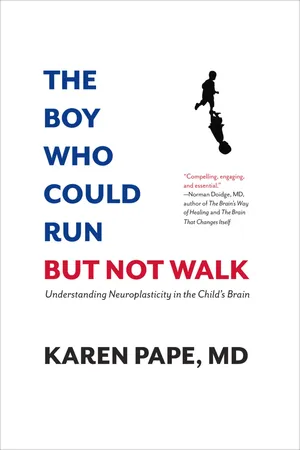
The Boy Who Could Run But Not Walk
Understanding Neuroplasticity in the Child's Brain
- English
- ePUB (mobile friendly)
- Available on iOS & Android
About this book
In this groundbreaking book, Dr. Karen Pape tells the story of how some children with early brain damage astounded everyone around them. The brain injury they suffered at or near birth had led to motor problems such as the awkward gait we associate with cerebral palsy. Yet they were able to run, kick a soccer ball, tap dance, and play tennis. This was not supposed to happen. It ran counter to the prevailing belief that the brain is hardwired and fixed. When Dr. Pape first shared her remarkable findings, she ran into fierce opposition from mainstream medicine. Yet this courageous neonatologist didn't back down.
In her clinical practice, Pape helped many young brain-damaged children to significantly improve their movement. It led her to ask why some of them could run but not walk with the same ease. Her answer was astounding: By the time they learned to run, their brains had healed. The awkward walking gait was actually a bad habit acquired while the brain was still damaged.
This is the power and the beauty of neuroplasticity, the brain's amazing ability to change and heal. It has revolutionized the treatment of adults who suffer stroke. Now, for the first time, this remarkable book shows that children with a brain injury at or near birth can get better, too. These stories of children's recovery and improvements are a revelation—surprising, inspiring, and illuminating. They offer real hope for some of the world's most vulnerable children and a better understanding of how the baby brain grows and recovers.
Frequently asked questions
- Essential is ideal for learners and professionals who enjoy exploring a wide range of subjects. Access the Essential Library with 800,000+ trusted titles and best-sellers across business, personal growth, and the humanities. Includes unlimited reading time and Standard Read Aloud voice.
- Complete: Perfect for advanced learners and researchers needing full, unrestricted access. Unlock 1.4M+ books across hundreds of subjects, including academic and specialized titles. The Complete Plan also includes advanced features like Premium Read Aloud and Research Assistant.
Please note we cannot support devices running on iOS 13 and Android 7 or earlier. Learn more about using the app.
Information
Table of contents
- Cover
- Title
- Copyright
- Dedication
- Contents
- Author’s Note
- Introduction: Starting a Revolution
- One: The Boy Who Could Run But Not Walk
- Two: The Heretical Teachers
- Three: Evidence of Baby Brain Neuroplasticity
- Four: Baby Brain Neuroplasticity Ignored
- Five: How Doctors Think
- Six: Use It or Lose It
- Seven: Personalized Neurorehabilitation
- Eight: Dance to the Music, Walk with Your Eyes
- Nine: The Girl Who Forgot Her Hand
- Ten: A New Theory of Spasticity in Children
- Eleven: What to Do in the First Four Years
- Twelve: What to Do in the Middle Years
- Thirteen: How Teens Can Make New Habits
- Fourteen: It Is Never Too Late to Change
- Fifteen: Aim for a Cure
- Acknowledgments
- Glossary
- Endnotes
- Resources
- Index
- About the Author